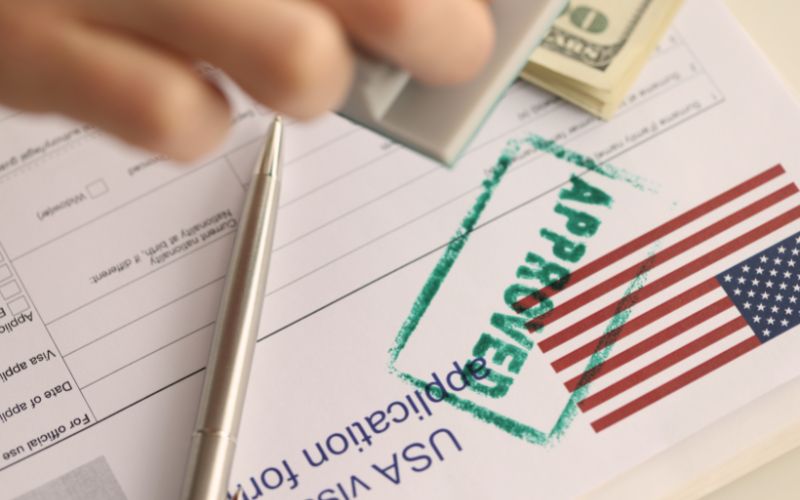E2 Visa to Green Card: A Step-by-Step Guide
Are you thinking about turning your successful U.S. business on an E-2 Treaty Investor visa into something more permanent? You’re not alone. The E-2 visa is a launchpad for foreign nationals eager to grow their new business here, but it’s important to know that the path from an e2 visa to green card isn’t automatic. This visa is non-immigrant and doesn’t directly lead to permanent residency.
That said, many entrepreneurs like you have successfully made the leap from an E2 visa to green card by exploring the right immigration pathways.
This guide is designed to be your friendly roadmap through that process. We’ll break down your Green Card options, clarify the steps involved, and share practical tips so you can confidently navigate what can feel like a complex immigration maze. Let’s get you closer to making the U.S. your permanent home.
Understanding the E-2 Visa
Specifically, the E-2 visa is a non-immigrant visa for nationals of countries with which the U.S. maintains a treaty of commerce and navigation. It permits individuals to enter and work in the U.S. based on a substantial investment in a bona fide enterprise. While renewable indefinitely, it doesn’t provide a direct path to permanent residency.
Key Limitations of the E-2 Visa
Temporary Nature: E-2 visa holders must demonstrate an intent to depart the U.S. upon visa expiration.
No Direct Path to Green Card: Unlike some visas, the E-2 doesn’t have a built-in mechanism for obtaining lawful permanent residency.
Business Dependency: The visa status is tied to the viability of the investment enterprise.
Nationality Requirement: Only nationals of treaty countries are eligible.
Transitioning from E2 Visa to Green Card: Step-by-Step

Step 1: Determine Your Eligibility
The E-2 visa is a powerful gateway for treaty investors, but it’s a non-immigrant visa—meaning it does not automatically lead to a Green Card. To move toward permanent residency, you’ll need to shift into an immigrant visa category that does.
The eligibility requirements vary depending on the Green Card pathway you choose.
Start by asking:
- Do I have the capital to make a larger investment (for EB-5)?
- Do I have an advanced degree, exceptional ability, or a track record of business success (for EB-1 or EB-2)?
- Do I work in a high-demand field with employer support (for EB-3)?
- Do I have close U.S. citizen or lawful permanent resident family members who can sponsor me?
This initial self-assessment will help narrow your options and ensure you invest time and resources in the most viable Green Card route. Moreover, working with an immigration attorney at this stage can help clarify your strongest strategy.
Step 2: Choose the Appropriate Green Card Pathway
EB-5 Immigrant Investor Program
The EB-5 visa offers a direct route to a Green Card for investors who:
- Invest $1,050,000 in a new commercial enterprise or $800,000 in a Targeted Employment Area (TEA).
- Create or preserve at least 10 full-time jobs for U.S. workers.
Importantly, E-2 investors can use their existing business as the basis for an EB-5 petition, provided they meet the investment and job creation requirements.
EB-2 Visa with National Interest Waiver (NIW)
The EB-2 visa is for professionals with advanced degrees or exceptional ability. The NIW allows applicants to self-petition without employer sponsorship if their work benefits the U.S. national interest.
EB-1 Visa
- EB-1A: For individuals with extraordinary ability in sciences, arts, education, business, or athletics.
- EB-1C: For multinational executives or managers employed abroad for at least one year in the past three years by a qualifying entity.
EB-3 Visa
Specifically, for skilled workers, professionals, and other workers. Requires employer sponsorship and labor certification.
Family-Based Green Card
If you have immediate relatives who are U.S. citizens or lawful permanent residents, they may sponsor you for a Green Card.
Step 3: Prepare and Submit Your Green Card Application

This step is where the rubber meets the road. It’s time to show the U.S. government why you deserve permanent residence, and that means pulling together a significant amount of paperwork. Don’t worry—it may sound intimidating, but it’s just about telling your story clearly and convincingly.
Gather Documentation
You’ll need to collect solid proof of your eligibility. This could include investment records showing you’ve put a significant amount into your new business, as well as detailed business plans illustrating its potential and how it creates jobs.
You may also need academic credentials if applying under categories like EB-2 or family documents if you’re applying through family sponsorship. The goal is to demonstrate the significant merit of your case.
File the Immigrant Petition
Next, you submit the right petition to the U.S. Citizenship and Immigration Services (USCIS). For employment-based applications, that’s usually Form I-140. For family-based sponsorships, it’s Form I-130. This petition asks the government to recognize your eligibility and start the permanent residency process.
Apply for Adjustment of Status or Consular Processing
If you’re already living in the U.S., you can file Form I-485 to adjust your status to a permanent resident without leaving the country. This step lets you stay and work legally while your application is processed, often for up to two years or more, depending on processing times.
If you’re outside the U.S., you’ll go through consular processing, which means attending an interview at a U.S. consulate or embassy in your home country. Either way, this step brings you closer to your Green Card.
Step 4: Attend the Interview
This part can feel like a big deal—and it is important—but remember, it’s just an opportunity for the immigration officers to verify your story. Whether you’re adjusting your status here in the U.S. or going through consular processing abroad, you’ll attend an interview where they’ll ask about:
- your background,
- your business investment,
- and your intentions in the U.S.
Think of this as your chance to confidently show how your new business adds value and meets the criteria for national importance, or how your family sponsorship is a genuine relationship.
Be honest, prepared, and clear. Your ability to communicate the significant merit of your case here can make a big difference.
Step 5: Receive Your Green Card and Celebrate
After all the waiting, paperwork, and interviews, the moment you’ve been working toward arrives—you get your Green Card. This document grants you lawful permanent residence in the U.S., meaning you can live and work here indefinitely, travel freely, and even sponsor family members down the line.
Keep in mind that that journey doesn’t stop here if you want citizenship someday, but for now, you’ve secured a stable foothold in your new home. It’s a huge achievement, and your patience and persistence have paid off.
Additional Tips and Considerations

Making the leap from an E-2 visa to permanent residence is more than just filling out forms. It requires careful planning and smart decisions. Here are some key tips to help foreign nationals like you navigate this journey with confidence:
Timing Is Crucial. Don’t Rush or Wait Too Long
Your E-2 visa is a non-immigrant visa, which means it expects you to return to your home country when it expires. But applying for a Green Card shows immigrant intent, meaning you want to stay permanently. This can create conflicts.
The key is to work with an experienced immigration attorney who knows when the best time is to file your Green Card application so it doesn’t clash with your current visa status. Getting this wrong can cause delays or even denials.
Your U.S. Business Is More Than Just a Job. It’s Your Immigration Asset
The business that qualifies you as a foreign investor on your E-2 visa can also be the foundation of your Green Card application.
If you’re pursuing an employment-based preference category like EB-5, make sure your investment and job creation meet the requirements. If you qualify for an EB-2 National Interest Waiver, focus on showing how your enterprise serves a purpose of national importance.
It’s not just about owning a business; it’s about proving your contribution benefits the U.S. economy.
Keep Working Legally with an Employment Authorization Document
Applying for your Green Card can take time. Fortunately, you might be eligible for an Employment Authorization Document or EAD, which provides work authorization and lets you keep working legally while your application is processed. It is important for maintaining financial stability and keeping your business running smoothly.
Your Family Matters. Include Them in Your Application
One of the biggest advantages is that your spouse and unmarried children under 21 of the same nationality can usually be included as derivative beneficiaries in your Green Card application. This allows your whole family to become green card holders and settle here permanently.
Traveling Back to Your Home Country? Do It Carefully
Be careful if you plan to visit your home country while your Green Card application is pending. Leaving the U.S. without an approved travel document like Advance Parole can cause USCIS to consider your application abandoned, which means starting over.
Always check with your immigration lawyer before making any international travel plans during this time.
Know the Employment-Based Preference Categories
Understanding the specific employment-based preference categories your application falls under helps you set realistic expectations regarding your status application. Each category, from EB-1 to EB-5, has different requirements, wait times, and processing details. Knowing where you fit makes the process less overwhelming.
Use Trusted Immigration Services to Guide You
This process is complex and mistakes can be costly. Working with professional immigration services ensures you have experts who understand your unique situation as a foreign national. They can help you navigate the legal complexities and give you the best chance of success.
From E2 Visa to Green Card – Making It Real
Let’s be real—navigating the U.S. immigration system can feel overwhelming. But if you’ve already built a business here on an E-2 visa, you’ve shown you have the drive, resilience, and vision to succeed. Now it’s about turning that temporary opportunity into a permanent future.
Going from an E2 visa to a Green Card isn’t automatic, but it is possible. Whether investing through EB-5, applying for an EB-2 NIW to prove your work has significant merit, or pursuing family sponsorship, there’s a viable path forward. With the support of trusted immigration services, you don’t have to navigate it alone.
Keep in mind—this isn’t just about ticking boxes on government forms. It’s about building a life here. Becoming a Green Card holder means you can grow your business, settle your family, and truly make the U.S. your home.
It gives you the ability to work legally (thanks to tools like the Employment Authorization Document), travel with peace of mind, and even set the stage for future citizenship if that’s your goal.
So take a breath, keep pushing forward, and don’t be afraid to ask for help. You’ve already taken bold steps as a foreign national and investor. Now it’s time to turn that bold move into something lasting.
Permanent residency is more than a status—it’s a foundation. And you’re closer than you think.